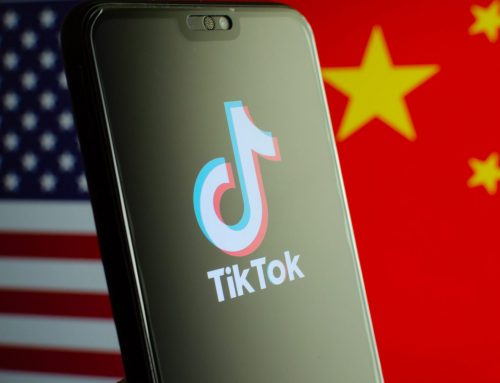Russia Toplines
The coronavirus remained the most dominant topic for the Russian media ecosystem last week, with no change in the amount of coverage from the previous week. In non-coronavirus coverage, two other topics of interest emerged: messaging (largely from government and diplomatic Twitter accounts) highlighted reports of rising anti-Semitism in the West, and coverage of the Biden-Poroshenko tapes sought to cast doubt on Ukrainian independence and the legitimacy of former Vice President and presumptive Democratic presidential nominee Joe Biden’s efforts to remove a former Ukrainian prosecutor general. Meanwhile on YouTube, RT America covered privacy and surveillance concerns surrounding coronavirus track and trace apps in the United States and negatively portrayed U.S. foreign policy in various regions.
China Toplines
The coronavirus remained ubiquitous in Chinese state media and government communications in the first half of last week. However, China’s annual parliamentary meetings, commonly referred to as the “Two Sessions,” featured prominently in Beijing’s messaging in the second half of the week. Announcements out of the Two Sessions and their subsequent promotion by Chinese officials and state media emphasized the Chinese Communist Party’s (CCP) empathy toward the suffering of Chinese citizens, as well as a corresponding ruthlessness towards anyone who would challenge the CCP worldview. On a different matter, China’s propaganda apparatus has also been mobilizing to defend the government’s plan to impose a new national security law on Hong Kong.
Russia
Russian Diplomats Emphasizing Anti-Semitism in Europe
Toward the beginning of last week, Russian government and diplomatic Twitter accounts engaged in a messaging push highlighting reports of increased anti-Semitism and neo-Nazism in Europe and elsewhere in the West, consisting of close to 130 tweets. At least some of this content was likely spurred by a controversial Mass held in Sarajevo last week for Croatia’s Nazi-allied soldiers and civilians killed at the end of World War II. This push coincided with continued World War II posts characterizing the Soviets as liberators and statements decrying the attempts to “rewrite history”:




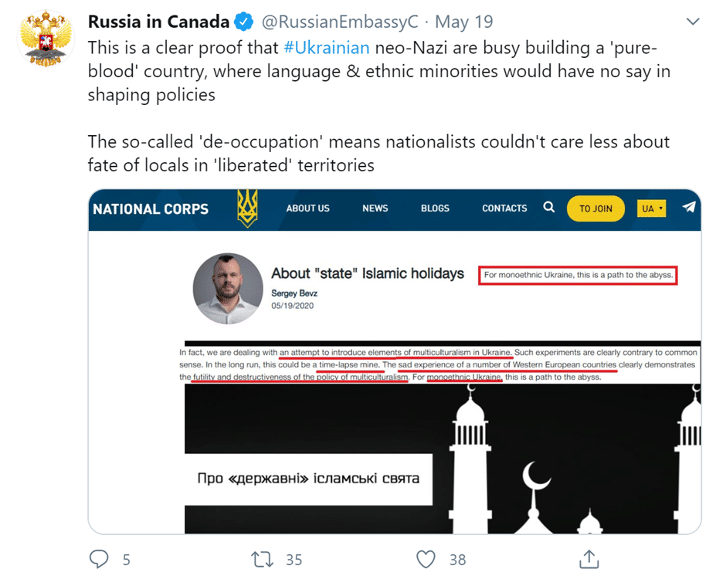
“Russia calls on Council of Europe not to ignore attempts at glorifying Nazism,” TASS, May 18, 2020.
“The Council of Europe should not ignore attempts at glorification of Nazism and desecration of monuments to Soviet soldiers who died liberating Europe from Nazism, the Russian foreign ministry said on Monday in a commentary on the beginning of Greece’s presidency in the Council of Europe’s Committee of Ministers.”
“Public Outcry as Bosnian Cardinal Serves Mass for ‘Victims’ Among Nazi Collaborators,” Sputnik News, May 17, 2020.
“In the run-up to the mass, the cardinal earlier said that such a religious gathering was not meant to celebrate anyone, but to commemorate “innocent victims”. Anti-fascist protesters staged a march in Sarajevo as the Catholic cardinal served a mass for “Bleiburg victims” – a group made up of pro-Nazi militants as well as civilians, executed by Yugoslav partisans at the end of World War II. The protesters blasted the mass, which was attended by no more than 20 people due to the coronavirus lockdown, deeming it a concealed attempt to rehabilitate Nazi collaborators, more specifically Croatia’s Ustasha militia that closely linked to the wartime fascist regime in Zagreb.”
“Mass for Nazi killers in Sarajevo: A toxic mix of WWII revisionism & modern politics,” Op-ed, RT, May 16, 2020.
“A Catholic Mass in the capital of Bosnia-Herzegovina for Nazi allies executed at the end of WWII is not a matter of religious freedom, but the latest and most egregious in a series of disturbing attempts to rewrite history.”
A few factors were at play here: first, Russia’s effort to portray itself as having the moral high ground on anti-Semitism due to its role in defeating the Nazis in World War II, despite what many in Central and Eastern Europe view as subsequent Soviet occupation—Russia often equates efforts to remove Soviet-era monuments with attempts to glorify Nazism; second, the complicated place in historical memory of anti-Soviet partisans in that region, who at times did collaborate with the Nazis; third, Russia’s longstanding effort to emphasize far-right extremism in Ukraine; and finally, Russia’s broader efforts to highlight racism and discrimination in the West.
The Biden-Poroshenko Tapes and Ukrainian Sovereignty
The West has upheld Ukrainian sovereignty as a key principle in its opposition to Russia’s annexation of Crimea and involvement in Donbas, while the Kremlin has often tried to cast doubt on Ukraine’s independence and called out what it characterizes as the West’s hypocritical stance on sovereignty. Last week’s publication of partial recordings from phone conversations between then-Vice President Joe Biden and former Ukrainian President Petro Poroshenko provided a new opportunity for Russia-backed media to highlight this message. Although the amount of coverage from tracked Russian state media and government Twitter accounts and news websites was quite small, they sought to play up supposedly new information contained in the recordings. RT in particular took the opportunity to claim again that Ukraine is a “client state” of the United States:


“He who pays the piper? Leaked tapes of Poroshenko-Biden calls fuel suspicions post-Maidan Ukraine is effectively US client state,” RT, May 19, 2020.
“On top of firing a prosecutor on orders from US Vice President Joe Biden, Ukrainian President Petro Poroshenko also robbed his own people by raising tariffs to please his US overlords, according to audio of their alleged calls . . . If [the calls are] true, however, they show the president in Kiev literally taking orders from Washington, even as the US insisted Ukraine was a sovereign and independent nation free to decide its own destiny.”
Of course, Russian state media also continued to characterize former Vice President Biden’s efforts to oust former Ukrainian Prosecutor General Viktor Shokin as an attempt to prevent investigation into his son, rather than part of established U.S. anti-corruption policies:
“‘Man of my word’: Leaked audio seemingly sheds light on Biden’s efforts to pressure Poroshenko into firing Burisma investigator,” RT, May 19, 2020.
“Audio recordings released by Ukrainian MP Andrii Derkach allegedly offer confirmation that Joe Biden pressured former Ukrainian President Petro Poroshenko to fire an attorney general in exchange for a billion-dollar loan. Former top Ukrainian prosecutor Viktor Shokin filed a criminal complaint in January, alleging that Biden had strong-armed Poroshenko into firing him while he was running multiple investigations into the Burisma gas company where Biden’s son Hunter was a board member.”
“Ukrainian Intelligence Says Fmr President’s Inner Circle May Have Leaked ‘Treasonous’ Biden Tapes,” Sputnik News, May 21, 2020.
“The probe into the Biden family’s alleged unlawful activities in Ukraine gained fresh impetus Tuesday after a Ukrainian lawmaker released recordings of conversations between Ukrainian ex-President Petro Poroshenko and former Vice President Joe Biden, revealing the extent to which Biden wanted to get a prosecutor investigating his family fired.”
“Alleged Recordings of Biden, Kerry Pressuring Ukraine’s Poroshenko to Fire Prosecutor Emerge Online,” Sputnik News, May 19, 2020.
“President Donald Trump and former Vice President Joe Biden were caught in the center of a major political scandal regarding the Biden family’s alleged corruption in Ukraine following the 2014 coup, as well as Trump’s alleged illegal efforts to have Biden investigated. Trump was acquitted of any wrongdoing following an impeachment trial in February. Independent Ukrainian lawmaker Andriy Derkach has released online audio recordings which he says are excerpts from conversations between former Ukrainian President Petro Poroshenko, former Vice President Joe Biden and former Secretary of State John Kerry related to an effort by the Obama administration to get a Ukrainian prosecutor general investigating potential corruption fired.”
Russian state-funded media and government and diplomatic corps accounts:
Top 10 Hashtags — May 16-22: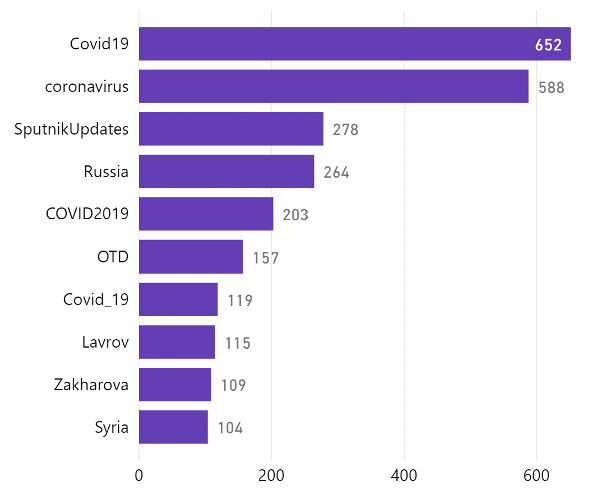
The Hamilton dashboard collected about 15,000 tweets from Russian state-funded media and government Twitter accounts from May 16-22 (figures as of 2pm May 22). Four of the week’s top ten hashtags mentioned the pandemic, and the total number of tweets mentioning “virus,” “covid,” and/or “outbreak” was close to 3,000. This was a slight increase compared to the previous week, though it was still down significantly from previous highs.
Websites
Russian government-funded websites:
Like the previous week, about 40 percent of output from Russian government-funded news websites collected on the dashboard last week mentioned “virus” in the first 200 words. As usual, this output consisted primarily of basic news updates, with some criticism of Western government responses and reporting on pandemic-related geopolitical tensions. Notable articles among the top ten by Facebook shares included two characterizing the “radical left” and social progressivism as censoring free speech:
“Trump vows to strip ‘radical left’ of ‘TOTAL COMMAND’ over FB, IG, Twitter & Google,” RT, May 16, 2020.
“President Donald Trump has vowed to break the “radical left’s” apparent control of social media platforms. Earlier, the president thanked his “keyboard warriors” for their support, as they accused the tech firms of censorship.”
“UN says ‘husband’ & ‘wife’ are now politically incorrect terms – but why is it allowed to serve as thought police?” Op-ed, RT, May 20, 2020.
“As millions of married couples around the world are feeling the strain of being holed up together due to the pandemic, the United Nations decided it’s a great time to remove the words “husband” and “wife” from our vernacular. In case anyone thought that the social justice warriors would take a much-needed hiatus from their crusading against wrong-think, especially at the height of a pandemic, think again. This week, UN bureaucrats found clever new ways to divide and alienate the global population at a time when social-distancing rules have already turned people into strangers.”
Broadcasts
Russian state-owned media:
About two-thirds of the videos collected from Russian state-owned media on YouTube last week consisted of pandemic-related coverage.
RT America put out several videos related to privacy concerns related to contract tracing apps in the United States, echoing similar messaging from RT UK about the U.K. government’s app in previous weeks:
“Contact Tracing: The Big Snoop,” RT America, May 15, 2020.
“Contact tracing has media outlets buzzing over its efficacy to curb the spread of Coronavirus and get our country back on its feet. But constitutional attorney John Whitehead explains how using our digital footprints to track us round-the-clock spells the end of our remaining rights to privacy.”
“Police can track COVID-19 patients’ housemates via apps,” RT America, May 20, 2020.
“COVID-19 patient data, including names and home addresses, is being shared with law enforcement in several states.”
“ACLU warns against COVID-19 contact tracing apps,” RT America, May 20, 2020.
“As tech giants Google and Apple are working to develop an app for COVID-19 contact tracing, some states are developing their own mechanisms. But the American Civil Liberties Union (ACLU) is rolling out guidelines advising against government overreach.”
A video on the coronavirus in Russia responded in part to claims that the country is underreporting coronavirus victims by highlighting supposed benefits of the inherited Soviet healthcare system—and contrasting it with U.S. healthcare issues:
“Why is Russia’s COVID-19 death rate low while cases are high?” RT America, May 15, 2020.
“Despite a large number of confirmed COVID-19 cases in Russia, the country has seen an astonishingly low death rate in the course of the pandemic.”
Finally, RT America put out several videos on U.S. foreign policy in various regions, largely painting the United States in a negative light. A few examples:
“US wants ISIS in Iraq to justify occupation – fmr Pentagon official,” RT America, May 20, 2020.
“Former Pentagon official Michael Maloof says ISIS is making a comeback in Iraq because of an array of variables that have created ideal conditions for the terrorist group.”
“US nukes in Poland will provoke Russia – fmr intel officer,” RT America, May 19, 2020.
“The US ambassador to Poland suggested in a tweet that US nuclear weapons could be housed in Poland. Former US Marine Corp intelligence officer and former UN weapons inspector Scott Ritter says such a move would only provoke Russia.”
“US miffed about China’s relationship with Israel,” RT America, May 18, 2020.
“China’s ambassador to Israel was reportedly found dead at his home near Tel Aviv. Although the circumstances do not seem suspicious, the United States is questioning China’s relationship with Israel.”
China
Coronavirus Competition
Consistent with the past several months, the global battle of narratives surrounding the coronavirus pandemic continued to fill a large portion of China’s official and state media communications. Following up on the U.S. week’s announcement last week that Chinese cyber attackers had attempted to steal coronavirus vaccine research, state media widely disseminated Xi Jinping’s speech to the World Health Assembly about making any Chinese vaccine a “global public good.”
Chinese state media made this point explicitly clear in the most-shared state media story on Facebook last week: “Chinese vaccines will be made global public good, says Xi” (CGTN, 19 May). Other content along those lines included “Xi: China to share vaccine with world” (China Daily, 18 May) and “China to develop COVID-19 vaccine as global public good, reflects nation’s intl generosity: analysts” (Global Times, 19 May).
Diplomats and embassies followed suit:
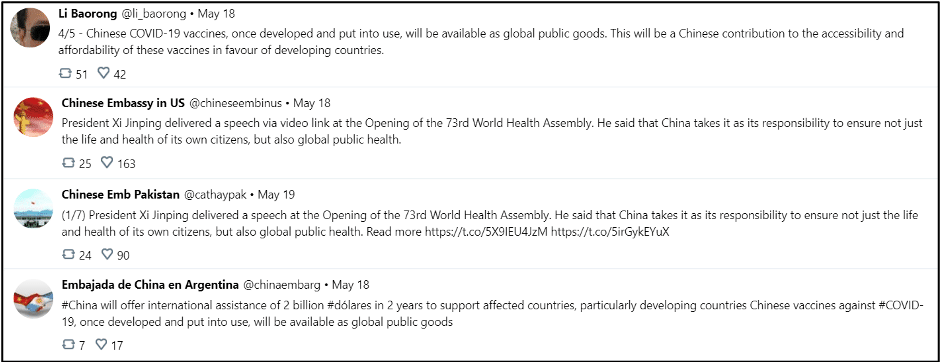
These statements implicitly draw an unfavorable parallel between China’s generosity and the selfishness of others, particularly the United States. But some content went the extra mile and made the point explicitly (in Xinhua’s case, by very selectively picking from international coverage to appear neutral):

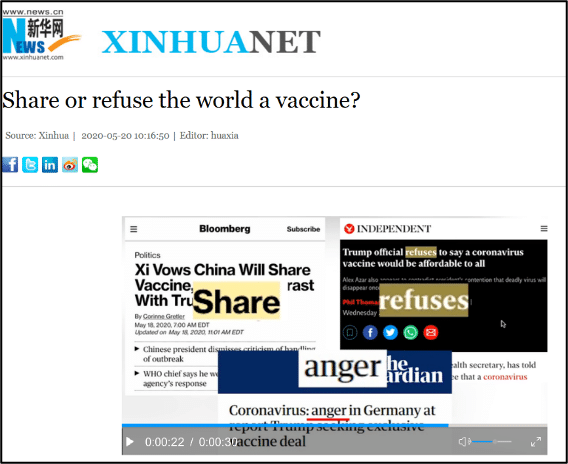
Reinforcing this contrast between an effective China and an incompetent United States, a steady stream of CGTN video content criticized the United States’ response to the pandemic last week.

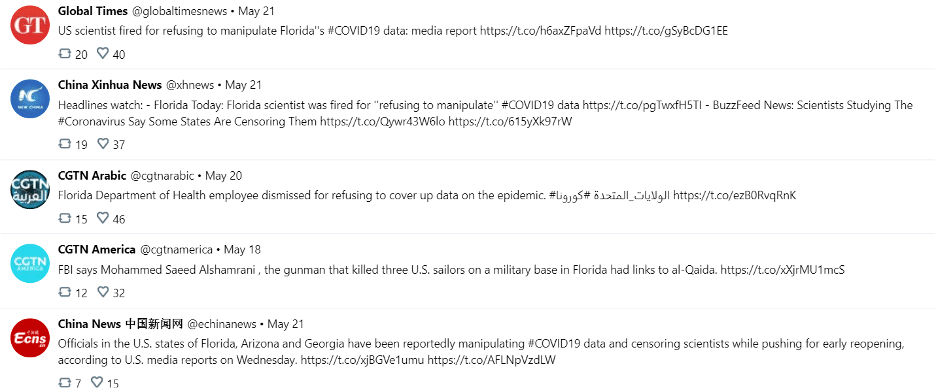
It is worth noting the particular vitriol with which the Chinese propaganda apparatus focuses on U.S. Secretary of State Mike Pompeo. In the vein of an earlier viral video posted by Xinhua trolling the Trump administration’s response to coronavirus, CGTN released a short video last week portraying Pompeo as the main protagonist of a videogame that sees him land on a “game over” screen after admitting that he “lied, cheated, and stole” during his tenure at the CIA.
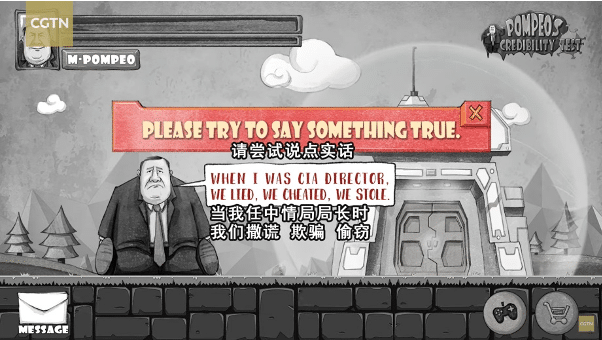
The Two Sessions’ Two Flavors
Other than coronavirus-related news, the major topic covered by China’s state media last week was the annual plenary sessions of the two organizations that make national-level political decisions: the National People’s Congress (NPC) and the National Committee of the Chinese People’s Political Consultative Conference (CPPCC).
Announcements out of this year’s edition came in two flavors: carrots and sticks. On the one hand, Beijing took pains to present a benevolent face to Chinese citizens who, after being battered by the coronavirus outbreak, are now facing a major economic downturn.
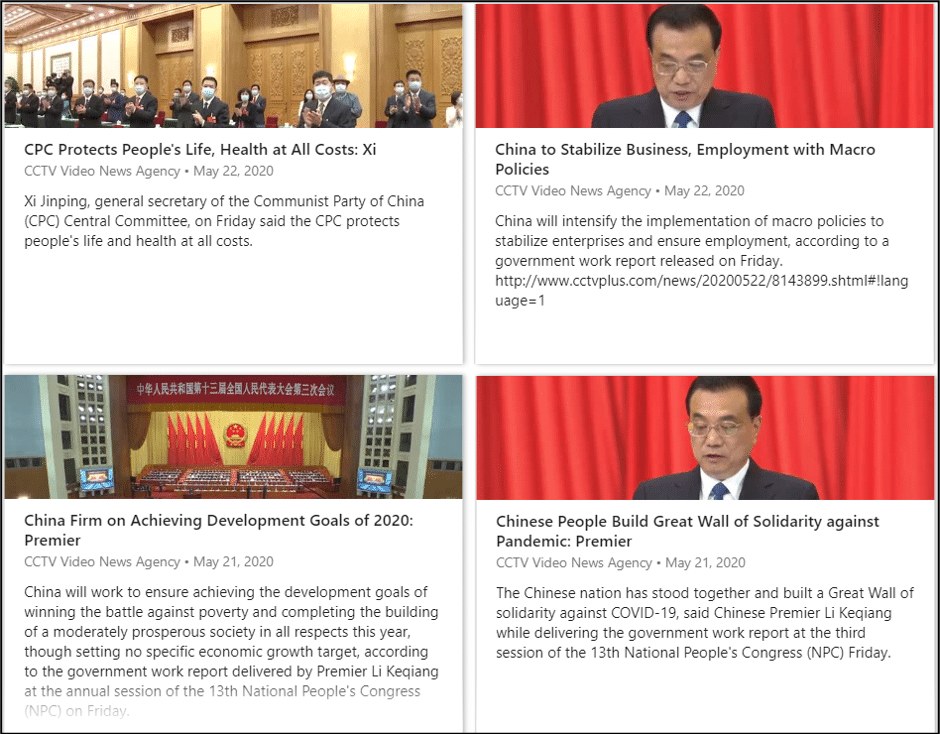
On the other hand, Beijing also appeared keen to signal to the world the strength of Chinese leadership, as the party announced several measures to that effect, notably on defense spending and Taiwan.
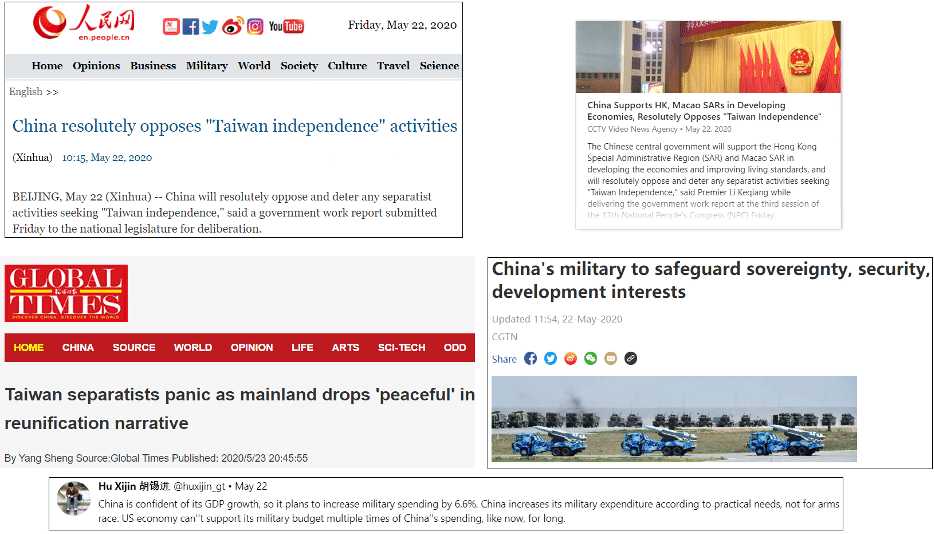
Drawing Battle Lines Around Hong Kong
The biggest of sticks came last Thursday, when Chinese authorities announced that they would be enacting a new security law in Hong Kong, in breach of the “One Country Two Systems” treaty that guaranteed the city’s autonomy until 2047. The move is intended to clamp down on the pro-democracy forces in the city. A search for tweets from the network of Chinese accounts monitored by Hamilton mentioning “Hong Kong” shows how rapidly the city became a focal point of Beijing’s propaganda apparatus.

The overarching message is that the Chinese authorities are stepping in to save Hong Kong from malevolent, and mostly external, forces. By way of illustration, the below image was tweeted by Xinhua news agency with the caption: “Anti-Hong Kong independence, anti-subversion, anti-terrorism, save Hong Kong.”
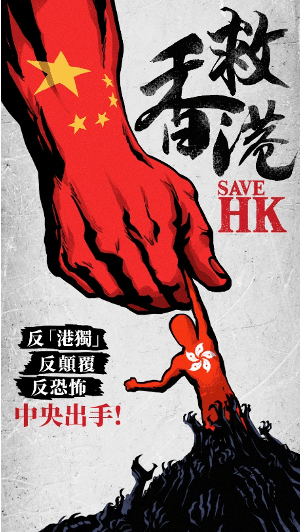
Particularly remarkable is the speed with which Chinese embassies around the world have moved to promote their benign interpretation of Beijing’s intentions. In the two days after the announcement, embassies in every G7 country issued official statements on China’s new national security law for Hong Kong.
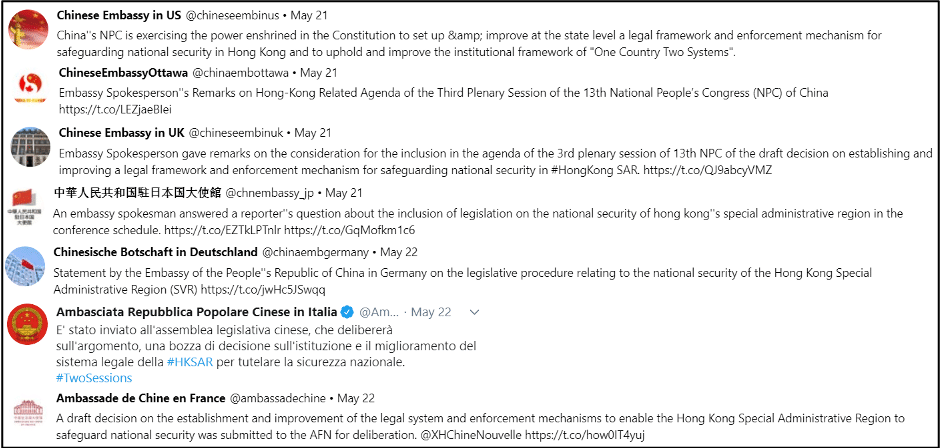
In a short piece published in March, ASD explained how the Hong Kong protests in 2019 were a catalyst for the rapid increase in China’s presence on Western social media. It seems that Beijing is now mustering the full strength of its network to control the narrative surrounding the national security law and the reaction it is sure to elicit, both in Hong Kong and abroad.
Chinese state-funded media and government and diplomatic corps accounts:
Top 10 Hashtags — May 16-22:
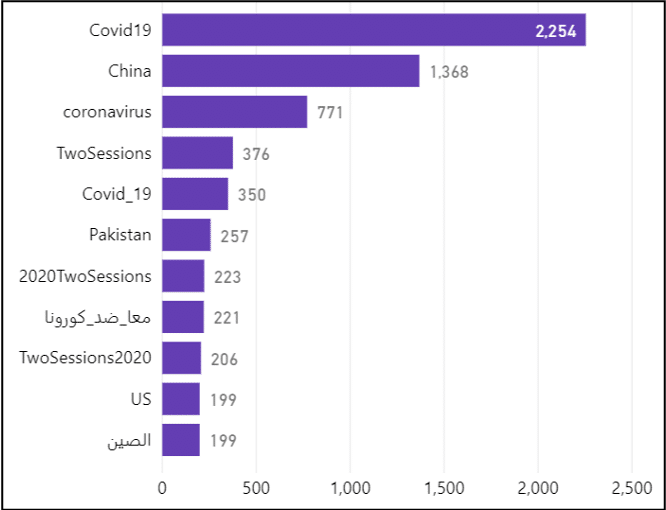
Websites
Chinese government-funded websites:
As in previous weeks, coronavirus-related coverage dominated stories published by Chinese state media. “COVID” and “pandemic” were the two most frequently recurring words in this week’s articles. Four of the top ten most shared state media articles on Facebook were critical of the Trump administration’s handling of the crisis or cast doubt on America’s preparation for a second coronavirus wave.
“Trump’s threats against WHO would only make America alone in the world,” CGTN, May 19, 2020.
U.S. President Donald Trump threatened to permanently pull funding from the World Health Organization (WHO) if it does not commit to major substantive improvements in the next 30 days. In a letter to WHO Director-General Tedros Adhanom Ghebreyesus, Trump expressed his disappointment and made numerous unwarranted accusations against the WHO on its “repeated missteps” and its dependence on China. The timing of the letter is noticeable when the World Health Assembly is convened and the Trump administration fails to control the COVID-19 that has killed more than 90,000 Americans as of late Monday.
“Trump says U.S. not to shut down in case of 2nd coronavirus wave,” Xinhua, May 22, 2020.
U.S. President Donald Trump said on Thursday that the United States would not close in the case of a second coronavirus wave. “A permanent lockdown is not a strategy for a healthy state or a healthy country. Our country wasn’t meant to be shut down,” the president said. “A never-ending lockdown would invite a public health calamity. To protect the health of our people we must have a functioning economy.”
Chinese state media also rallied to the defense of Chinese technology company Huawei. Articles published last week criticized the United States for blacklisting Huawei, while also taking a swipe at Taiwan for walking into a “semiconductor trap set by US.”
“China resolutely opposes U.S. action against Huawei,” CGTN, May 17, 2020.
“China has urged the U.S. to “stop its wrongdoings immediately and create conditions for its businesses to carry out normal trade and cooperation.” The comments came after Washington announced new export controls on Huawei that limit the tech giant’s access to semiconductor technology.”
“How Taiwan walked into the semiconductor trap set by US,” Op-ed, China Daily, May 20, 2020.
On Thursday evening, the Taiwan Semiconductor Manufacturing Corp announced a new $12 billion investment in a new Arizona factory in the United States to produce semiconductors in the country rather than relying on exports from Taiwan. The project will be completed in 2024. But less than 12 hours after that announcement, the US Department of Commerce imposed sweeping new restrictions against Chinese telecommunications company Huawei, prohibiting all companies (including overseas ones) using technology and software produced by the US from selling semiconductors and parts to Huawei.
Broadcasts
Chinese state-owned media:
Videos posted on Chinese state media’s YouTube channels consistently focused on the dire economic climate in the United States.
“Job insecurity during COVID-19,” CGTN America, May 21, 2020.
“More than 36 million Americans have lost their jobs as the COVID-19 pandemic continues to rattle the labor market.”
“Faces of Unemployment: Makeup artist at department store in NYC,” CGTN America, May 16, 2020.
“I miss my co-workers and I cry a lot (…) the other day I was crying all day, you know, about people that I know that are sick. My brothers, I just want them to be healthy.”
“Economist William Lee on the how the pandemic is affecting the job market,” CGTN America, May 20, 2020.
“The hope is when we unlock the economy, the small and medium sized-companies will come back, and a lot of the medium-sized companies are contractors to the larger ones. And the larger ones have ties to various international companies, including Huawei.”
Lastly, Chinese state media continued to push conspiracy theories tied to Fort Detrick.
“Myth of U.S. Military Lab at Fort Detrick,” CCTV, May 17, 2020.
“Fort Detrick was originally a secret facility for germ warfare. Bacteria studied at fort Detrick included anthrax, a deadly and highly infectious agent that has been used in terrorist attacks.” Cue images of COVID-19 testing stations. “In July 2019, however, research at Fort Detrick came to a halt (…) due to safety concerns.” The video proceeds to cast doubt over the investigation into the incident and concludes that all this “should raise concerns over the safety of U.S. biological research.”
The views expressed in GMF publications and commentary are the views of the author alone.







